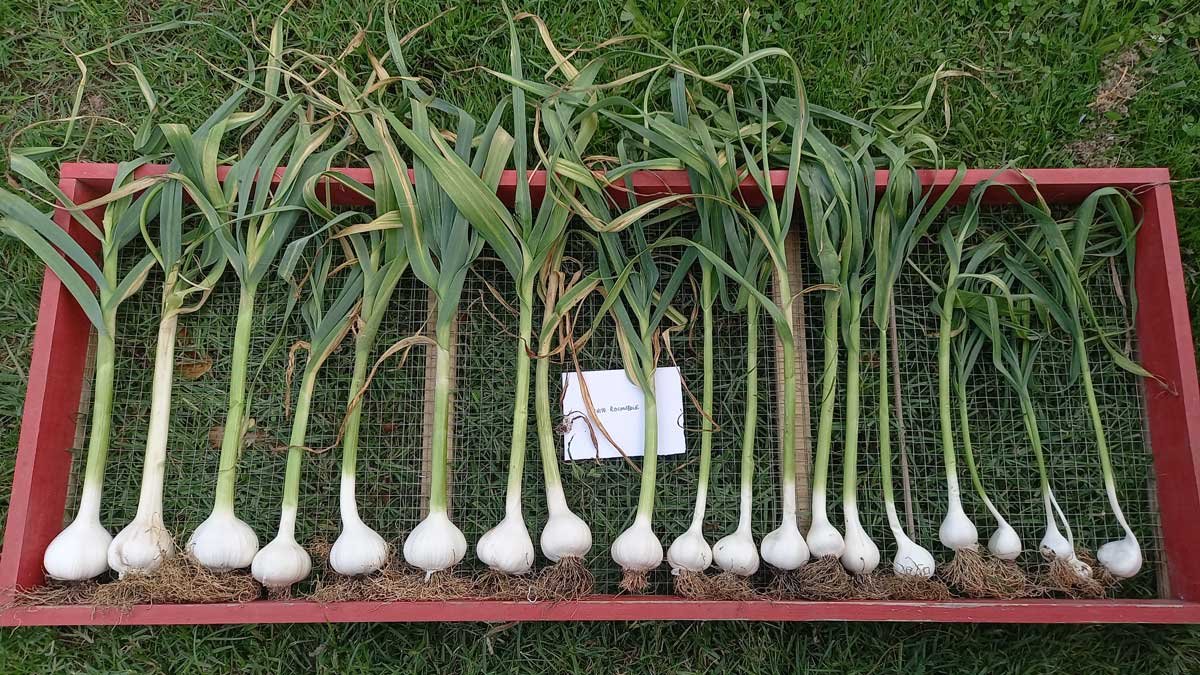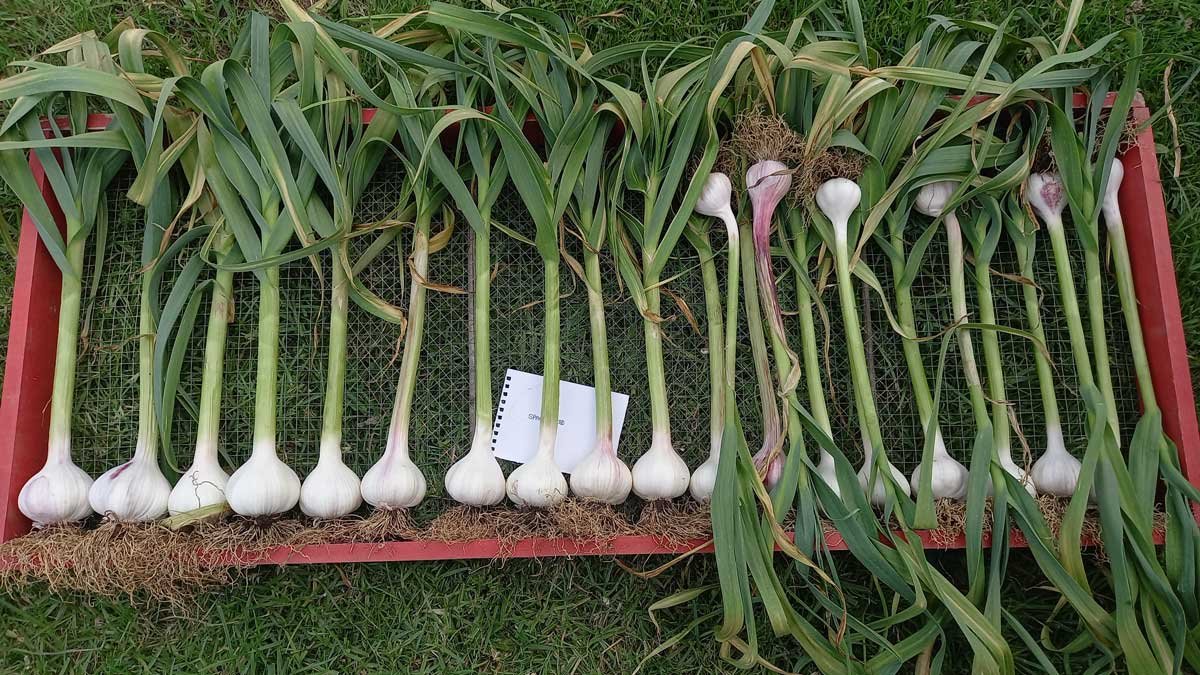There’s been so much rain lately that I’ve been really worried about my garlic. The moisture encourages fungal diseases, and I’ve really begun to see the problems increase throughout the garden.
Last week, I saw the first few rust spores appearing on my garlic crop. It was unsurprising – we had 6 dry days all November, and December isn’t looking much better. But it was a light infection and late enough in the season that it wouldn’t do much damage.
Then earlier this week I spotted some plants just kind of… melting. A stem rot (I’m not sure exactly which kind of rot) that eats away at the skins and kills the stems had begun establishing. That was going to be a real issue. Once that takes hold, the garlic can’t be dried for long-storage.
We planted on 22 June, so 16 December felt like a pretty OK time to pull them up. We tentatively dug a few up to find that yes, the garlic was ready. And we needed to get a hustle on!
Container clean up
The first problem was we didn’t really have the drying area set up at all. We usually pick a fine day in spring and clear out the accumulation of stuff in the container. Re-sort it, re-stack it, and clear a space for the incoming harvests (which also include catnip, potatoes, squash, pumpkin, and the various culinary and medicinal herbs I decide to dry).
But we didn’t really have a fine day in spring. So here I was in summer, sweating it out in a hot container trying to work out what to do with bags of mint and chamomile I dried in 2018 (we added it, along with a bag of dill seed and dried rosemary, to the chicken food).
A couple of podcasts later, I’d got to the point where we had room to dry the garlic. And it had stopped raining. So it was time to harvest the garlic.
By variety
The Takahue came up first. The stem rot was just beginning to get to it. We cleared off the affected skins, putting it aside on the drying racks as we went.
Normally we’d let it dry outside in the sun for a few days, but weren’t going to get the chance. So the plan was lift it, clean it up, get it on the racks, and get the racks indoors.

But it was beautiful. Big bulbs were popping out of the soil. The scent of garlic was in our noses as we worked.
Then came the White Rocombole. The variety I probably came closest to losing last year. Again, big beautiful bulbs popped out of the soil. What did grow, grew beautifully.

The Purple Rocombole was next. All just stunning. The outer layers were a deep purple but as they came off, the inners were whiter. I’m hoping they colour-up again as they dry.

Finally, I wondered about the Ajo Roja and the Spanish Red. We pulled up two test Ajo Roja and they were not ready at all. They’re not looking the greatest and I’m not sure how they’ll go with any more rain, so fingers are crossed, but I might lose that strain yet.
The Spanish Red, however, were huge. Giant red bulbs sprung from the ground as we lifted the gardening fork. Again, they lost a lot of colour as we tidied them up, but it’s safe to say that by this stage I was positively beaming.

That left the Russian Red. It still looks robust, healthy. The scapes are still emerging.
I’d like to give it another fortnight before I even try, but I’ll be keeping a close eye on it.
A different time
This was a hugely different experience to last year’s garlic harvest – an event so traumatic for me that I didn’t blog about it for 6 months.
The thing about this year is it was a much smaller job. Both Richard and I made comments wishing we had this year’s size and last year’s numbers. We grew beautiful garlic, but the truth is we didn’t grow much of it. Not by our standards anyway.
This year it took a couple of hours to lift, clean up, and put away. It was also good garlic – the kind of garlic that makes you cry ‘woah!’ in delight as you lift it up.
There are a few bulbs which were designated ‘Garlic Salt’ – formed bulbs, but not good enough to even attempt to dry naturally. I turn these into garlic salt which makes a pretty popular Christmas gift – but it would be less than 5% of the total crop. There was less than one bucket of waste.
Last year I spent days harvesting tiny rotting bulbs and I generated three garbage bins of waste. It took almost two weeks of processing to rescue what I did.
There’s a night and day contrast between the two experiences.
What’s next?
In a few weeks, once they’re dry, I’ll sort the garlic into ‘growing’ and ‘eating’. Because we grew so little this year, I probably won’t have any spare for sale.
The majority of it will go back into the ground next winter. Maybe the things we’ve learned over the last couple of seasons will mean we’ll finally get a great harvest to sell to gardeners in 2024. Good things take time, I guess?
We’re looking at a few spots around the farm as options for establishing new beds over the next couple of months in preparation for planting next year. We’ve been out turning over soil and checking drainage this week to help us make our decisions.
It’s been a ride, but at least 4 of these varieties will soldier on for another season. This year we’ve been reminded of how fun it is when it goes right.



Wonderful news. I used to think garlic was a plant and forget. After all, it is used to help other plants grow, so it should be completely disease free. Well now we know. BTW. I was talking to a guy who grows salad crops in Bali. He gets A LOT of rain. His solution, which may become relevant here, is to grow on long mounds almost a 2 metres wide by 1 metre high AND covers then with hoops and plastic sheet to keep the rain off. He says plants need air almost as much as they need water. And too much water keeps the air out. Also, when the crop is finished, he puts it into the trough between the mounds and turns the whole mound over onto the crop leftovers – he doesn’t drag it away to compost and bring back when it is ready – in situ composting. He grows lettuce, corn, beans and all sorts. Mainly for tourists who rock up, tell him what they want, and he harvests it there and then. So fresh, so delicious. Enjoy your summer break. Thanks for a fascinating year of blogs.
I agree – raised rows are probably the way we’ll go in the future – drainage is absolutely critical! I’ve seen some of NZ’s commercial growers using them too. Fingers crossed we can come up with something that works well. Thanks for reading!
So pleased at the mostly good news about your garlic! I’ve been nervous for you with this endless rain:(
Thanks Suzi, I appreciate your well wishes! It’s made me quite nervous as well, but looks like we’ve averted disaster!